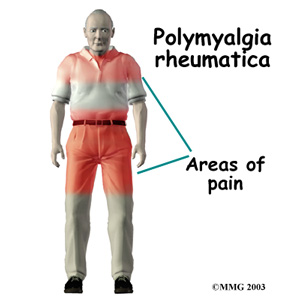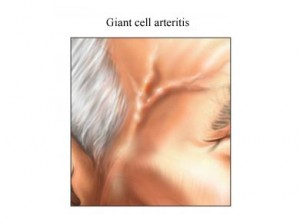Are you suffering from muscle pain and stiffness in the hips, shoulders and neck? You may be having Polymyalgia Rheumatica, a medical condition commonly affecting large muscles in the body.
Polymyalgia Rheumatica Definition
Page Contents

Picture 1 – Polymyalgia Rheumatica
Source – wordpress
Polymyalgia Rheumatica (PMR) is a health syndrome that causes pain or inflammation in the large muscle groups of different body parts. Upper arms, shoulders, thighs, hips and neck are the common body regions that are affected due to this condition. The disease mainly affects women and people in the above-50 age group. It is also seen in men, though not as widely as in women. Studies show that women are three times more susceptible to the condition than men. People below 50 years are rarely affected by this syndrome. About 1 in every thousand people over 50 years develop PMR in the US every year.
Polymyalgia Rheumatica means “pain in many muscles” in Greek. “Poly” stands for “many” while “myalgia” stands for “muscle pain”.
Polymyalgia Rheumatica Symptoms
The condition gives rise to a wide variety of symptoms in sufferers. Most of these are internal in nature. Some of the prominent symptoms of Polymyalgia Rheumatica include:
Pain
Suffering people normally experience pain in the affected region. The pain can be moderate or severe. Acute pain may affect the daily activities of the patient.
Inflammation
Patients may also suffer from an inflammation apart from the pain in the affected muscle. There may be swelling in the tendons of hands or feet (tenosynovitis) and even the joints.
Stiffness
Many sufferers also experience a stiffness or hardness in the muscles that are impacted by the syndrome. The stiffness is normally worse in the morning, which makes it very difficult to get out of bed. Common activities that involve raising your arms above shoulder level may cause difficulties.
Appetite Loss
In some cases, the patient may also suffer from a lack of appetite.
Weight Loss
The lack of appetite and fever may also lead to a drop in the weight of the affected person.
Fatigue
Many people also experience tiredness after the onset of the disease.
Anaemia
The condition also leads to a drop in the blood cell count of sufferers.
Fever
The affected person may also suffer from fever, which may be similar to flu.
Polymyalgia Rheumatica and Giant Cell Arteritis

Picture 2 – Giant Cell Pictures
Source – lifescript
In many cases, the condition appears along with another disease called Giant Cell Arteritis which leads to swollen arteries in the head. The swelling of the arteries may cause blurred vision and headaches. The sufferers also commonly have pain the jaw and tongue. It is unclear how Temporal Arteritis and Polymyalgia Rheumatica are related. However both the diseases are supposed to be somehow associated to each other as many Polymyalgia Rheumatica patients also suffer from Giant Cell Arteritis. About 15 per cent people in the US alone have both of these conditions. Giant Cell Arteritis symptoms may appear along with Polymyalgia Rheumatica symptoms. They may also arise after Polymyalgia Rheumatica symptoms have disappeared.
Polymyalgia Rheumatica Causes
Medical research has not been able to pinpoint the exact reason behind the development of Polymyalgia Rheumatica. However, there are certain factors that are held responsible for this condition. These are :
Blood Cell Abnormality
An abnormality in leucocytes in the bloodstream, generally thought to be an infection- induced immune response, is supposed to be the cause of the inflammation. This abnormality leads the white blood cells, which otherwise protects the body from bacterial and fungal attacks, to turn against the system. It attacks the lining of body joints which leads to swelling of the joints.
Heredity
The condition is also believed to arise due to generic factors. Some medical researchers are of the opinion that the disease passes from parents to offspring through the gene.
Polymyalgia Rheumatica Diagnosis
Many of the symptoms of Polymyalgia Rheumatica are very similar to those displayed by patients suffering from other conditions. A proper diagnosis of the disease is, therefore, very essential. The condition is generally diagnosed with the help of blood examinations like ESR (Erythrocyte Sedimentation Rate) Test and CRP (C-reactive protein) Test. These blood tests show the exact cause of swelling and generally confirm if PMR is responsible for the inflammation.
Carrying out Ultrasound Tests on the affected muscle group can also determine the presence of PMR. X –Rays can correctly ascertain the cause of joint pain.
Polymyalgia Rheumatica Treatment
The aim of treatment for Polymyalgia Rheumatica is to reduce inflammation as well as relieve stiffness and pain. Rest, proper medications for Polymyalgia Rheumatica and exercise are generally enough to cure the condition.
The treatment of Polymyalgia Rheumatica is usually carried out with corticosteroid medicines like Prednisone. Most Polymyalgia sufferers generally respond to low doses of Prednisone administered daily. The quantity of dosage may be altered depending on how quickly the symptoms start going away. It can also differ from person to person. The medicine can cause side effects like weight gain, diabetes, glaucoma or rise in blood pressure. But patients should stop taking the drug only after consulting their doctor as Corticosteroid medicines interfere with the natural functioning of the body. The dosage should be gradually reduced for best effect.
Polymyalgia Rheumatica cure may also be carried out with anti-inflammatory drugs of non-steroidal variety such as Aspirin or Ibuprofen. These are to be taken daily, although long term use may give rise to stomach irritation.
Exercise is also very helpful in curing Polymyalgia Rheumatica syndrome. Proper exercise along with rest can help bring back joint mobility in sufferers. Workouts also increase strength and functioning of muscles. Deep breathing exercises and massages can relieve stress and relax the affected muscle.
Polymyalgia Rheumatica Diet
Dietary modifications are also quite effective in combating the condition. Adding components that fight off the causes of Polymyalgia Rheumatica can aid the treatment process. These ingredients include
Vitamin E
It promotes muscle strength and flexibility.
Vitamin C
It boosts blood vessel performance and helps combat inflammation.
Herbs
Oil of herbs like Evening Primrose creates anti-inflammatory compounds that help in reducing swelling rapidly. The root of Devil’s Claw has also been proved to be very effective in curing Rheumatic disorders.
Polymyalgia Rheumatica Prognosis
This is not a very serious condition and rarely leads to permanent impairment. Even in the absence of treatment, the syndrome may go away after a year or a few years. But treatment is needed to control the symptoms very quickly. However, stopping the treatment too early can lead to a relapse of the syndrome. Relapses are generally rare and occur in 25% patients.
Polymyalgia Rheumatica patients have a risk of developing Giant Cell Arteritis (GCA) at a later stage. Giant Cell Arteritis is a serious condition and may lead to temporary or permanent vision loss. In worst cases, the patient may suffer a stroke. This is why GCA and Polymyalgia Rheumatica need to be treated at the earliest.
Polymyalgia Rheumatica is not very serious but if it leads to Giant Cell Arteritis you need to watch out. It is best to cure the disease in its early stages to prevent the arising of any complicated condition in future. If you are having from the condition yourself or have someone suffering from it in your family, it is best to seek immediate medical attention.
References:
http://en.wikipedia.org/wiki/Polymyalgia_rheumatica
http://www.patient.co.uk/health/Polymyalgia-Rheumatica.htm
http://www.mayoclinic.com/health/polymyalgia-rheumatica/DS00441
http://emedicine.medscape.com/article/808755-overview
http://www.healthscout.com/ency/68/217/main.html
http://www.wrongdiagnosis.com/p/polymyalgia_rheumatica/causes.htm
http://www.nlm.nih.gov/medlineplus/polymyalgiarheumatica.html

Excellent info for a long time PMA sufferer. Recent left buckle side of cheek was recently radiated and PMA pains seem enhanced on left head and neck. Do you have recommned treatments, besides 5ml prednisone and Tylenol? Age is 86, male, lost weight, only partially regained after radiation.